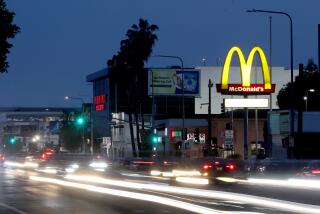Let the States Decide on Driving 55 : Speed limit: The 1974 national law was an overreaction; legislation to repeal it is overdue.
- Share via
Prohibition, the sanctimonious attempt of a relative few to regulate the morality of the many, was the law of the land for 15 years. From 1918 until repeal in 1933, it became the second-most-violated law in American history. But this sorry episode has been trumped by an even more disdained and violated law, which has now lasted 21 years: the Emergency Highway Energy Conservation Act of 1974, better known as the 55 m.p.h. national maximum speed limit.
Last week, the Senate voted to repeal this onerous federal law and return the power to set speed limits to the states, from which it should never have been removed. The House should now do the same immediately and President Clinton should sign it. The Senate legislation is also the official policy of the American Automobile Assn., which is not noted for endorsing dangerous bills.
The current law has imposed immense financial hardships on millions of American motorists while having virtually nothing to do with actual highway safety.
In late 1973, following the Yom Kippur War in Israel, the newly formed OPEC oil cartel created a worldwide, strictly temporary and artificial oil shortage. Americans panicked in long gas-station lines, Congress overreacted and on Jan. 2, 1974, decreed a maximum national speed limit of 55 m.p.h.
States that defied the edict--and one or two tried--would find their federal highway funds abruptly curtailed. This “temporary” law was arbitrarily made permanent on Jan. 4, 1975, as the federal highway amendment, with mass civil disobedience the direct result. And an “unholy trinity” of special interests--law enforcement agencies, insurance companies and radar-detector manufacturers--has gotten rich from its enforcement.
Police departments and highway patrols are reaping vast rewards--duly funneled to state and municipal treasuries to help balance their budgets--by enforcing the letter of the law. The net effect is particularly nasty in those seven northeastern states (New York, New Jersey, Pennsylvania, Connecticut, Rhode Island, Delaware and Maryland) that refused to join their fellows in raising rural interstate speed limits from 55 m.p.h. to 65 m.p.h., after Congress permitted this single exception to the rule in 1987. (On June 6, New York Gov. George Pataki signed legislation that will remove his state from this oppressive list Aug. 1. The Legislature was influenced by a finding that 96% of all rural interstate motorists in New York were exceeding the 55 m.p.h. limit.) In Pennsylvania, one diligent state trooper wrote more than 5,000 speeding tickets in 1990 while hiding at the bottom of a hill in the middle of nowhere on the Pennsylvania Turnpike, collecting more than $625,000 in fines.
Auto insurance companies gouge policyholders unmercifully for three years after a single ticket. A recent Wall Street Journal story revealed that auto insurers had complained to Washington about a minor drop in the strict enforcement of “Drive 55” at the state level because their obscene profits from piggybacking on ticket issuance were slightly lower as a result.
Radar-detector manufacturers have sold more than $3.5 billion of their product in the past 15 years and now have laser detectors to offer as well. Were speed limits reasonable in the first place, none but reckless drivers would need these devices.
The politically correct doctrine on this issue has been simple: “Driving 55 saves lives and energy resources.” This argument is disingenuous.
A Federal Highway Administration study in 1990 by two respected federal highway engineers said that most speed limits are 8 m.p.h. to 12 m.p.h. below the prevailing travel speed and 15 m.p.h. or more below the maximum safe speed. Further, increasing speed limits to reasonable levels would not result in still-higher speeds but would increase voluntary compliance and target enforcement at the occasional violator and truly high-risk driver.
As for the argument about saving energy, today’s cars get more than twice the gas mileage of those on the road 21 years ago. And no responsible person is now claiming that a true crisis in petroleum availability exists--if it ever did.
A further, major retribution has arisen since 1992: Most major rental-car firms will refuse to rent to anyone with as few as three minor speeding tickets or eight driver’s license “points” in a two-to-three-year period.
This issue is about big money, plain and simple. It is now up to Congress to admit its error and change the law, so that the responsible motorist gets the even break that he has been denied for far too long.
More to Read
Sign up for Essential California
The most important California stories and recommendations in your inbox every morning.
You may occasionally receive promotional content from the Los Angeles Times.













